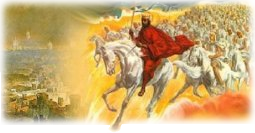This section includes any books, pamphlets, or articles by Adventist pioneers, Millerites, or anything else related to the Second Advent message which does not come directly from my church.
I will include some items from the Brinsmead Awakening of the late 1950’s to early 1960’s, since it was a revival of the 1888 “Everlasting Gospel” message, and an important milestone in the history of our church.
Any items related to the revival of the 1888 message in that time period (1950-1960) will also be included here.
Items (arranged by date of publication)
The Royal Law Contended For (1658) by Edward Stennet
Wesley on the Law (1771) by John Wesley
The End of the Wicked (1777) by Samuel Bourn
For Missionaries After the Apostolical School (1824) by Edward Irving
The Rest of the Sabbath (~1822-1832) by Edward Irving
Life & Writings (1826-1844) by Charles Fitch
The Seven Churches of Revelation (1842) by William Miller
The Reformation: Yesterday & Today (1844) by Sylvester Bliss
The Seventh-Day Sabbath (1845) by T. M. Preble
The Sanctuary (1846) by O. R. L. Crosier
The Shorter Works of James White (1842-1881) by James White
Cutting Reproof (1850) by James White
Solemn Review of the Sabbath (1855) by Elihu
The Four Universal Monarchies (1855) by James White
The State of the Churches (185x) by M. E. Cornell
The Two Thrones (186?) by James White
The Rock of Ages (1860) by E. H. Bickersteth
Life Incidents (1868) by James White
Argument from the Types (1868) by James White
The Sanctuary of the Bible (186?) by J. N. Andrews
The Sounding of the Seven Trumpets of Revelation 8 and 9 (1866) by Josiah Litch / James White
The Life and Labors of Joseph Bates (1868) by Joseph Bates
Discussion on the Sabbath Question (1870) by M. E. Cornell
Miraculous Powers (1875) by M. E. Cornell
Facts for the Times (1875) by M. E. Cornell
Christ in the Old Testament (1877) by James White
Bible Adventism (1878) by James White
Sabbath Collection (1851-1875) by J. N. Andrews
Conditional Immortality Collection (1854-1889) by J. N. Andrews
The Complete Testimony of the Fathers (1876) by J. N. Andrews
The Atonement (1884) by J. H. Waggoner
Bible Hygiene (1890) by James White
Wine and the Bible (189x) by J. H. Kellogg, M.D.
God is Love (1897) by George Fifield
The Gospel of the Kingdom (1900) by W. W. Prescott
Wrested Scriptures Made Plain (1900) by W. E. Shepard
Letters to the Churches (1957) by M. L. Andreasen
The Vision by the Hiddekel (1957) by Robert Brinsmead
God’s Eternal Purpose (1959) by Robert Brinsmead
The Image of a Man (196?) by Robert Brinsmead
What Was the 1888 Message? (196?) by Robert Brinsmead
The Three Angels’ Messages in the Book of Daniel (196?) by Robert Brinsmead
How is Perfection Possible? (196?) by Robert Brinsmead
How to Keep the Doctor Away (196?) by Robert Brinsmead
Man Born To Be King (1966) by Robert Brinsmead
Gems of Truth, Book 1 (1961-1967) by Robert Brinsmead
Gems of Truth, Book 2 (1957-1970) by Robert Brinsmead
Restoration and Revelation (1969) by Robert Brinsmead
The Battle for the Mind (1971) by Robert Brinsmead
The Royal Law Contended For
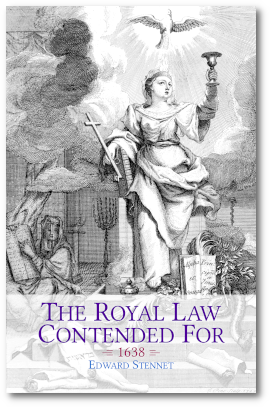 While researching some early Advent material, I came across a reprint of this article in the defense of the seventh-day Sabbath, from the days of the Dissenters in the mid-1600’s. Part of it was reprinted in the Review and Herald of September 2, 1851. Here is the description they gave:
While researching some early Advent material, I came across a reprint of this article in the defense of the seventh-day Sabbath, from the days of the Dissenters in the mid-1600’s. Part of it was reprinted in the Review and Herald of September 2, 1851. Here is the description they gave:
The friends of the Sabbath will be interested in the remarks of Edward Stennet as a valuable relic of the past. “He,” says the publisher of the American edition of his work, “was the first of the series of Sabbatarian ministers of that name, who for four generations continued to be among the foremost of the Dissenters in England. He suffered much of the persecutions which the Dissenters were exposed to at that time, and more especially for his faithful adherence to the cause of the Sabbath. For this truth, he experienced tribulation, not only from those in power, by whom he was a long time kept in prison, but also much distress from unfriendly dissenting brethren, who strove to destroy his influence.”
This is one of the earliest discussions of the Sabbath that I am aware of, and it also contains what might be the first printed observation that the Sabbath and Marriage are twin institutions passed down to us from Eden. 65p
Here is the excerpt from the book:
The two ancient institutions of the Lord in Paradise were Marriage and the Sabbath, both which are called and esteemed honorable. “Marriage is honorable in all” (Hebrews 13:4); and in Isaiah the Sabbath is called “…the Holy of the Lord, honorable” (Isaiah 58:13); and Christ leads us to the beginning of them both. When the question was whether men might put away their wives for every fault, the answer is, that Moses did but suffer it to be so, because of the hardness of their hearts, but from the beginning it was not so. Matthew 19:34-37. And when the Pharisees were so ignorant, that they thought works of mercy were not to be done upon the Sabbath day, Christ leads them to the first institution of it, and tells them it was made for man. Mark 2:24, 27. Both these institutions were made for the good and benefit of man in his Paradise estate, which is sufficient proof for their duration. Paul says, that “The man was not created for the woman, but the woman for the man.” 1 Corinthians 11:9. And our blessed Lord of the Sabbath said that “The Sabbath was made for man, and not man for the Sabbath.” Mark 2:27.
Wesley on the Law
 Here are three main sermons from John Wesley, one of the primary founders of the Methodist Church, and leader of the revival of religion in England (and elsewhere) in the 1700’s.
Here are three main sermons from John Wesley, one of the primary founders of the Methodist Church, and leader of the revival of religion in England (and elsewhere) in the 1700’s.
These sermons stand in stark contrast to the antinomian teaching that is common in many of the churches of today. They show that Wesley had a good grasp of the role of the Law in the work of salvation.
The importance of the Law in God’s final presentation of the everlasting gospel to the world is shown by such verses as these:
Revelation 14
12 Here is the patience of the saints: here are they that keep the commandments of God, and the faith of Jesus.
The Methodist revival of the mid to late 1700’s was the last major Christian revival before the great Second Advent movement of the early to mid 1800’s. What Wesley has written here confirms a continuity of truth, and verifies that the Advent movement was in the line of the progressive unfolding of the light of God. And to those who still hold the “everlasting gospel” as the way to establish the Law in the heart, the light continues to shine, more and more unto the perfect day. 57p
Contents
- The Law: Origin, Nature, Properties, and Uses
- The Law Established Through Faith – I
- The Law Established Through Faith – II
The End of the Wicked
 Here is an early work on the topic of the final end of the wicked, or “annihilation.” The view of the author is in contrast to the common doctrine held by many churches, that the soul is immortal and the souls of the wicked will be tormented in hell fire, forever and ever.
Here is an early work on the topic of the final end of the wicked, or “annihilation.” The view of the author is in contrast to the common doctrine held by many churches, that the soul is immortal and the souls of the wicked will be tormented in hell fire, forever and ever.
The minister, Samuel Bourn, thought this common idea put a very bad light on God’s character and justice. He argues in this work, that punishing people beyond what is warranted by their crime is a mark of tyrrany and that the actual Bible teaching was that the wicked would suffer “according to their works,” and this pointed to a limited suffering, until their lives were extinguished.
This was a rare view in the late 1700’s, and Bourn was in advance of many of the ministers of his day, on this topic. It is interesting to read his reasoning about how the false view of God’s character led to penances, bigoted zeal, and inhumane cruelty through persecutions like the inquisition. He also argues that the true view, that God is both just and merciful, leads to true repentance. 35p
Contents
- The End of the Wicked
- Human Misconceptions of God
- God’s Goodness and Love
- The Punishment of the Wicked
- God’s Justice and Mercy Lead to Repentance
- Extreme Injustice Leads to Penances and Bigoted Zeal
- False Image of God Impressed Upon Men
- Inhumane Cruelty in the Name of Religion
- The Inquisition Patterned After False Justice
- God’s True Character Draws and Uplifts Man
- False Doctrine Inspired by the Devil
- The True Gospel Upholds Justice and Mercy
- The World to Come
- Appendix: A Letter concerning the Christian Doctrine of Future Punishment
For Missionaries After the Apostolical School
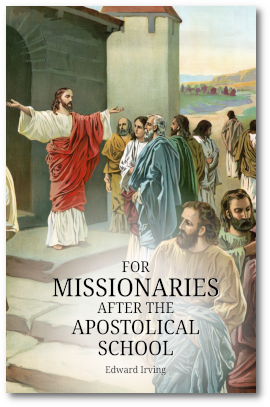 Edward Irving was invited by the London Missionary Society, in 1824, to preach one of their anniversary sermons. Normally, this would be an occasion where the minister was expected to present to donors the worthiness and needs of the Missionary Society. Irving saw it as a divine call to investigate the Bible teaching about the Missionary office.
Edward Irving was invited by the London Missionary Society, in 1824, to preach one of their anniversary sermons. Normally, this would be an occasion where the minister was expected to present to donors the worthiness and needs of the Missionary Society. Irving saw it as a divine call to investigate the Bible teaching about the Missionary office.
What opened to his mind, and was afterwards presented in the sermon, was a faithful account of the Missionary office, as Jesus instituted it. It was so radically different from the way Missionary work was practiced that the sermon caused great dismay, and quite a bit of indignation.
Irving presented the Missionary as a person without any earthly attachments; unbound from the world, as a living representative of the reality of spiritual connection and sustenance, so that the teachings of the Missionary, and his personal example, were in complete harmony, and both designed to break the spell of the world and worldly attachments from the mind of the hearers, and lift them to fasten their faith on heavenly things instead.
And this is just the way Jesus sent out the apostles, without “scrip, or bread, or money.” (Mark 6:8) And therefore, it is the God-approved Biblical way. In this unique volume, Irving explores the reasons why it must be so, in order to fulfill the purpose of God, and have His blessing and the full cooperation and manifestation of the Divine powers. 132p
The Rest of the Sabbath
 This is Edward Irving’s defense of the Sabbath commandment.
This is Edward Irving’s defense of the Sabbath commandment.
Of course, in common with many ministers of his era and prior, the day of the sabbath was considered to have been changed to Sunday. But nevertheless, a day of rest, as commanded in the law, was considered to be binding upon Christians.
So this booklet gives a nice summary of the spiritual reasons why a Sabbath is necessary and beneficial to all Christians. 12p
Life & Writings
 Out of the storehouse of truth, we are to bring forth “things new and old” (Matthew 13:52). And so we present this important collection of sermons, books, letters, poems, and articles, from one of the foremost early Advent ministers, Charles Fitch.
Out of the storehouse of truth, we are to bring forth “things new and old” (Matthew 13:52). And so we present this important collection of sermons, books, letters, poems, and articles, from one of the foremost early Advent ministers, Charles Fitch.
His life and works are particularly important for many reasons:
- He was in the top tier of Advent ministers, and also known and respected in the religious world of his time.
- His spirit of openness to accept new truths as they quickly unfolded marked him especially as a man whom the Spirit of God could lead “into all truth.”
- He led out in a number of significant milestones: the Second Angel’s message, and the 1843 Prophetic Chart.
- His emphasis on holiness was unique among the Millerite leaders, and foreshadowed the ministry of Waggoner and Jones.
- He was one of the few early Advent ministers whom Ellen White, in her first vision of the future kingdom, saw in heaven.
For all these reasons, and more, his work stands forth for our contemplation. It is as if the Spirit of God were calling, “Here is a man who followed Me faithfully; consider his ways, and be wise.” This work will give you a front row seat in the development of the early Advent message, and a new appreciation of the spiritual power that was in that movement.
Contents (only the major articles)
- A Brief Biography
- View of Holliston: A Century Sermon
- An Address: The Constitution and Slavery
- Slave Holding Weighed in the Balance of Truth
- Views of Sanctification
- Letter to the Newark Presbytery
- Reasons for Withdrawing from the Newark Presbytery
- The Power of the Gospel
- Letter to Rev. J. Litch, on the Second Coming of Christ
- A Wonderful and Horrible Thing
- The Glory of God in the Earth
- Come Out of Her, My People
- Immortality
- Sermon: They Knew Not the Time
I have only included some of the longer works in this Contents list. There are also many Letters, Reports, Poems, a color copy of the 1843 Chart, and much more. 602p
The Seven Churches of Revelation
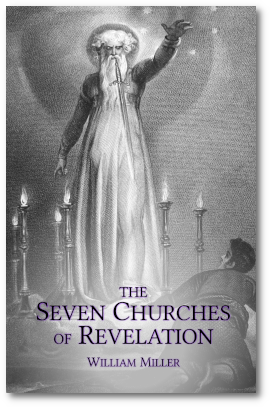 William Miller was the man who began the Advent revival in America, in the late 1830’s to mid 1840’s.
William Miller was the man who began the Advent revival in America, in the late 1830’s to mid 1840’s.
The two articles that make up this work were taken from a collection of Lectures, published in 1842.
In this work, the seven churches of Revelation 2 and 3 are treated prophetically, as covering seven periods of church history, from the apostles’ time to the return of Christ.
It is a good example of how the early Advent message combined the gospel and prophecy into a united and powerful call to repentance and consecration. 46p
Contents
- The Seven Churches of Revelation
- A Figure of the Christian Dispensation
- Ephesus
- Smyrna
- Pergamos
- Thyatira
- Sardis
- Philadelphia
- Laodicea
The Reformation: Yesterday & Today
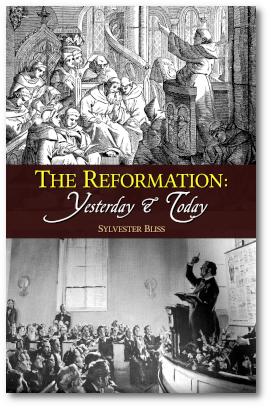 This interesting article was written by Sylvester Bliss, a minister, editor, and author in the Millerite movement.
This interesting article was written by Sylvester Bliss, a minister, editor, and author in the Millerite movement.
Written in September 1844, shortly before the disappointment of October 1844, this booklet covers some of the history of the German Reformation under Martin Luther (taken from D’Aubigne’s History of the Reformation), and draws some parallels between that reformatory movement, and the Advent movement. 30p
Contents
- The Reformation: Yesterday & Today
- Humble Beginnings
- The Bible vs. Tradition
- Disputations with Learned Adversaries
- Misrepresentations
- The Rise of Fanaticism
- A Manifold Battle
- The Feeble Become as David
- The Parallel to Today
- Satan’s Last Parochial Calls (Poem)
The Seventh-Day Sabbath
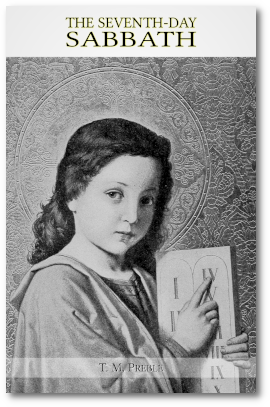 This tract on the Sabbath, from 1845, was the first to appear among Adventists. It led to the conversion of J. N. Andrews and other Advent families in Paris, Maine, as well as to Joseph Bates.
This tract on the Sabbath, from 1845, was the first to appear among Adventists. It led to the conversion of J. N. Andrews and other Advent families in Paris, Maine, as well as to Joseph Bates.
It’s a short pamphlet, but sums up nicely most of the main truths that established the seventh-day Sabbath as the correct day, “according to the commandment.” 12p
Contents
- The Sabbath to the Saints Scattered Abroad
- Supplement
The Sanctuary
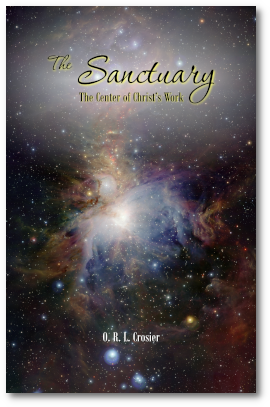 A classic work from the early Advent days. O.R.L. Crosier, who wrote this treatise on the Sanctuary truth, was a young man, who was involved in the Millerite revival and lived through the Great Disappointment of October 22, 1844. The day after, his friend, Hiram Edson, while going out into a field to pray, received a vision in which he saw Christ, not coming to the earth as they had expected, but coming into the Most Holy Place of the Heavenly Sanctuary, to “cleanse it” in the antitypical fulfillment of the “Day of Atonement”.
A classic work from the early Advent days. O.R.L. Crosier, who wrote this treatise on the Sanctuary truth, was a young man, who was involved in the Millerite revival and lived through the Great Disappointment of October 22, 1844. The day after, his friend, Hiram Edson, while going out into a field to pray, received a vision in which he saw Christ, not coming to the earth as they had expected, but coming into the Most Holy Place of the Heavenly Sanctuary, to “cleanse it” in the antitypical fulfillment of the “Day of Atonement”.
This light on the Sanctuary in heaven and Christ’s ministry there, explained the disappointment, and opened up large areas of truth. It is a key in understanding the book of Revelation, which is filled with “temple language”.
Edson, Crosier, and another friend, studied the topic for a while, and then Crosier wrote out the results in this short but concise treatise. It is quite impressive to see how much they grasped and how thorough their study was. These men were Bible students! Some of the topics discussed are:
- The parallel between the Old Testament Sanctuary services and the “pattern” or real Temple in heaven where Christ ministers.
- The division of that temple into Holy and Most Holy, and the significance of that division in the Heavenly Sanctuary.
- The seven basic feasts that distinguished the religious Year, and their antitypes.
- The difference between the forgiveness of sin from the sinner and the blotting out of sin from the sanctuary.
- The fact that the Day of Atonement was not fulfilled at the Cross.
- The Scapegoat transaction as a symbolic picture showing how sin will eventually be put back on it’s author, Satan.
There are other copies of this document floating around on the web, but some of the reasons why this one is superior are as follows:
- I have carefully reformatted the whole document for maximum ease of reading;
- The PDF is bookmarked and the Contents items are hyperlinked;
- All Bible quotes are set apart, and any erroneous references were corrected;
- Sub-headings have been added;
- I’ve added a further letter from Crosier from May 1846 which outlines the autumnal types in more detail; and
- I’ve added a 1945 Advent Review article from W. A. Spicer, entitled “A Meeting with O.R.L. Crosier”.
These features should make this the most complete and most accessible production of this important early document. Highly recommended. 86p
Contents
- The Law of Moses
- Legal Types and Antitypes
- The Sanctuary
- The Priesthood of Christ
- The Antitype
- The Age to Come
- The Scape-Goat
- The Transition
- Closing Salutation
- Appendix A: Notice
- Appendix B: A Further Letter
- A Meeting with ORL Crosier
Solemn Review of the Sabbath
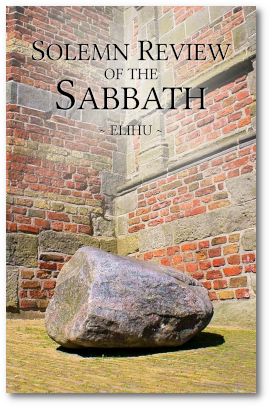 This unusual booklet, written under the pseudonym “Elihu,” is a discussion of the Sabbath written by a man associated with the Seventh-day Baptist church, and published as a tract sometime in the 1830’s. The tract was found by an Adventist in a house, and shown to James White, who published it in the Review and Herald in 1853, then as part of a collection in 1854, and as a separate tract in 1855.
This unusual booklet, written under the pseudonym “Elihu,” is a discussion of the Sabbath written by a man associated with the Seventh-day Baptist church, and published as a tract sometime in the 1830’s. The tract was found by an Adventist in a house, and shown to James White, who published it in the Review and Herald in 1853, then as part of a collection in 1854, and as a separate tract in 1855.
It is particularly forceful and direct in pointing out the New Testament example of Sabbath-keeping, and in upholding the Sabbath as part of God’s unchanging and eternal Law.
I have included an article at the end of the booklet by R. F. Cottrell, who located the man behind “Elihu,” and visited him in 1880. 21p
The Shorter Works of James White
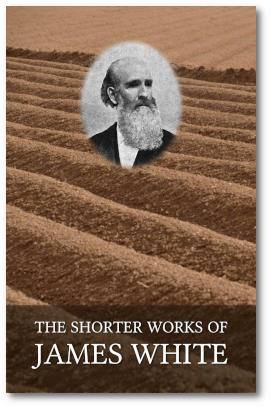 For probably the first time ever, the shorter works of James White are gathered together into one volume. This includes writings that appeared as pamphlets, booklets, and articles.
For probably the first time ever, the shorter works of James White are gathered together into one volume. This includes writings that appeared as pamphlets, booklets, and articles.
The collection begins with the sole article James White wrote in 1842 during the Millerite revival, defending the literal fulfillment of prophecy. The next work is “A Word to the Little Flock” in 1847, and from thereon his pen was very active. There are works on the Sabbath, the Sanctuary, The parable/prophecy of Matthew 25, Conditional Immortality, Revelation 14, the Judgment, the Second Advent, Spiritual Gifts, and the Gospel.
I’ve included a section at the end with songs from his second hymnal, “Hymns for Second Advent Believers” (1852).
This is a very rich collection, from the pen of the man who was mainly responsible for establishing the various branches of the Seventh-day Adventist church work, and who was a pioneer of pioneers. It will give the reader a good foundation in Seventh-day Advent doctrine and faith: how it formed, how it developed, and how it was defended. 1365p
Contents
- Letter to Rev. L. F. Dimmick (1842)
- A Word to the Little Flock (1847)
- The Seventh Day Sabbath Not Abolished (1850)
- The Third Angel’s Message (1850)
- The Sanctuary, 2300 Days, & Shut Door (1850)
- Brother Miller’s Dream (1850)
- The Bible Sabbath (1851)
- The Parable (1851)
- Our Present Position (1851)
- The Seventh-day Sabbath (1851)
- Revelation 14: A Brief Exposition (1851)
- Babylon (1852)
- Nathaniel White: A Brief Account (1853)
- My Lord Delays His Coming (1853)
- Appeal on Immortality (1854)
- Unfulfilled Prophecy (1855)
- The Seventh Day of the Week (1855)
- Preach the Word (1855)
- The Judgment (1857)
- Ascension Robes; Slander Refuted (1861)
- Personality of God (1861)
- The Seven Seals (1862)
- War and the Sealing (1862)
- Death and Burial (1864)
- The Second Advent (186x)
- The Judgment (1865)
- The Gospel of the Kingdom (ND)
- The Two Thrones (1865)
- Perpetuity of Spiritual Gifts (1870)
- The Law and the Gospel (ND)
- God’s Memorial (187x)
- The Way of Life (1876)
- The Redeemer and Redeemed (1877)
- Christ and the Sabbath (1877)
- Articles from Review & Herald and Signs of the Times (1871-1881)
- In Memoriam by EGW (1881)
- Songs (1852)
Cutting Reproof
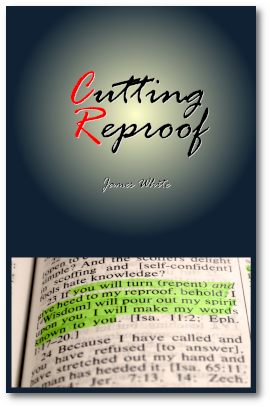 James White wrote this article and published it in the Advent Review of 1850. It deals with the Sabbath commandment, and it’s prophetic relevance for the last days.
James White wrote this article and published it in the Advent Review of 1850. It deals with the Sabbath commandment, and it’s prophetic relevance for the last days.
It is mainly aimed at Adventists, or those who have a fairly good understanding of the prophetic basis of Adventism, and it is interesting to note that the light on the Sabbath commandment opened up further understandings in the later half of the book of Revelation which had not been fully grasped by the Millerites before 1844. 27p
Contents
- The Seal or the Mark
- The Elijah Message
- Human Ingenuity–A False Hope
- Rise of Spiritualism
- Liberty of Conscience Set Aside
- Precious Promises
Solemn Review of the Sabbath
 This unusual booklet, written under the pseudonym “Elihu,” is a discussion of the Sabbath written by a man associated with the Seventh-day Baptist church, and published as a tract sometime in the 1830’s. The tract was found by an Adventist in a house, and shown to James White, who published it in the Review and Herald in 1853, then as part of a collection in 1854, and as a separate tract in 1855.
This unusual booklet, written under the pseudonym “Elihu,” is a discussion of the Sabbath written by a man associated with the Seventh-day Baptist church, and published as a tract sometime in the 1830’s. The tract was found by an Adventist in a house, and shown to James White, who published it in the Review and Herald in 1853, then as part of a collection in 1854, and as a separate tract in 1855.
It is particularly forceful and direct in pointing out the New Testament example of Sabbath-keeping, and in upholding the Sabbath as part of God’s unchanging and eternal Law.
I have included an article at the end of the booklet by R. F. Cottrell, who located the man behind “Elihu,” and visited him in 1880. 21p
The Four Universal Monarchies
 Here’s a reproduction of an early Advent publication, edited by James White, which drew heavily from an 1843 Millerite series of articles on Daniel 2, 7, 8 & 9 by George Storrs.
Here’s a reproduction of an early Advent publication, edited by James White, which drew heavily from an 1843 Millerite series of articles on Daniel 2, 7, 8 & 9 by George Storrs.
It covers the basic prophetic outline of the four monarchies: Babylon, Medo-Persia, Greece, and Rome. These are the foundational prophecies that every other prophecy of the last days is built upon.
The prophetic details are interpreted clearly and concisely. It’s a nice short introduction for a new believer, or for someone who just wants to brush up on their knowledge of the basic prophecies. 53p
Contents
- Daniel 2: Nebuchadnezzar’s Dream
- Daniel 7: Vision of the Four Beasts
- Daniel 8 & 9: Vision of the Ram, He-Goat, & Horn
The State of the Churches
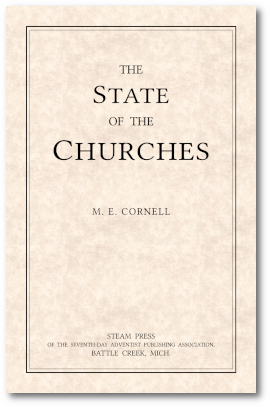 Merritt Cornell was an early Adventist, who participated in the Millerite movement, and was brought into the Seventh-day Adventist church through the labors of Joseph Bates.
Merritt Cornell was an early Adventist, who participated in the Millerite movement, and was brought into the Seventh-day Adventist church through the labors of Joseph Bates.
This is the first of a series of smaller publications from his hand. He had a talent for gathering and organizing quotations from sources past and present, to support the present truth.
This booklet is about the decline of spirituality in the churches who had rejected the gospel in the Advent awakening. Some of the things mentioned might seem rather mild to us today, as the apostasy is much more developed in our time. But this booklet shows the beginnings of that world-bound drift, and can serve to help us analyze our own lives, to make sure we are not walking the same downward path. 32p
The Two Thrones
 Here is another in a series of early Advent pamphlets by James White.
Here is another in a series of early Advent pamphlets by James White.
The Two Thrones deals with the topic of the throne (or kingdom) of grace, and the throne (or kingdom) of glory. A correct understanding of these two thrones, and how they relate to each other, is absolutely essential to a correct understanding of the prophecies, and the work of the Gospel.
It is because this topic is not clearly understood, that so-called Christians in the past tried to set up a theocracy on earth, which resulted in persecution and bloodshed.
A failure to accept the light on the kingdoms of Grace and Glory, that God caused to be proclaimed in the Advent movement, will result in a second experiment in a false theocracy, which will bring about the end of this world. 37p
Contents
- The Two Thrones
- Throne of the Father
- Throne of the Son
- The Great Image
- Establishment of Christ’s Kingdom
- The Word “Kingdom”
- The Kingdom in Miniature
- The Kingdom of Grace
- Wheat and the Tares
- Grain of Mustard Seed
- Parable of the Leaven
- The Hidden Treasure
- Pearl of Great Price
- The Gospel Net
- The Ten Virgins
- Blessings of the Kingdom
- The Kingdom at Hand
- The First Advent
- The Second Advent
- The Kingdom Complete
- Fitness for the Future Kingdom
The Rock of Ages
 In 1860, Edward Henry Bickersteth published this book to show some of the immense amount of scriptural evidence for the Godhead: the divinity of the Father, Son, and Holy Spirit.
In 1860, Edward Henry Bickersteth published this book to show some of the immense amount of scriptural evidence for the Godhead: the divinity of the Father, Son, and Holy Spirit.
At that time, Unitarianism was making inroads, with its teaching that Christ was a created being, and that the Holy Spirit was just the power of God. A variation of these teachings is now being circulated among the fringes of Adventism. It is simply a revival of the old Arian teachings from the early centuries of the church.
When I was a young Christian, I read Bickersteth’s book, and it really solidified my grasp on the Godhead. Recently I’ve met a few acquaintances who were swayed by this modern Arian teaching, so I thought it would be good to present this book in a more modern format. It is the most complete and thorough work I know of on this subject.
I’ve included a 30-page Foreword that discusses this topic from an Adventist point of view. There is a discussion of some of the statements from the Adventist pioneers, who are often quoted to support these mistaken views.
I would also recommend reading the following books which discuss Christ’s divinity and humanity, in the light of the 1888 message: The Living and the Dead, Melchizedek, The Destiny of a Movement.
As an interesting side note, Bickersteth’s father was also a minister, and played a significant role in the Advent awakening in England. He wrote a book titled, A Practical Guide to the Prophecies, which came to similar conclusions on many of the prophetic topics as those held in the American Advent movement. 219p
Contents
- Preparation for the Study
- Trust in God, the Creator
- Trust in the Lord Jesus Christ
- The Deity of Jesus Christ
- The Condescension of Christ
- The Divinity of the Holy Spirit
- Life in the Godhead
Life Incidents
 This book is a classic from the early Seventh-day Adventist church.
This book is a classic from the early Seventh-day Adventist church.
It is James White’s history of the early Advent movement, including the progress of the development of doctrine and prophetic understanding, as well as the development of faith and experience.
It is a record that traces the Lord’s leading in unfolding truth to the Advent movement. 338p
Contents
- Ancestry and Early Life
- William Miller
- The 2300 Days
- My Public Labors
- Rise and Progress of Adventism
- The Exeter, N. H., Camp Meeting
- The Passing of the Time
- The Seventh Angel
- The First Message
- The Second Message
- The Third Message
- Rise and Progress of the Third Message
- Glance at the Past
- The Tongue of Slander
- Present Position and Work
- The Law and the Gospel
- God’s Memorial
Argument from the Types
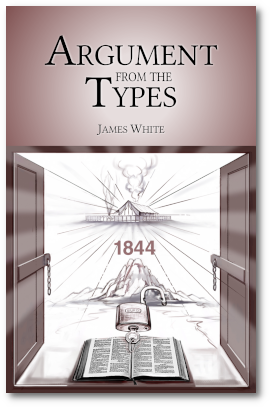 This is a chapter from the book, Life Incidents, by James White. It covers a few of the prophetic arguments that flowed from the revelation of the Sanctuary truth, revealed just after the disappointment in 1844.
This is a chapter from the book, Life Incidents, by James White. It covers a few of the prophetic arguments that flowed from the revelation of the Sanctuary truth, revealed just after the disappointment in 1844.
The topic of the Heavenly Sanctuary, where Christ ministers as High Priest, shed new light on the foundational Advent prophecy, the 2300 years of Daniel 8:14. It also gave new significance to the parables/prophecies of Matthew 22 and 25, showing the order and significance of events to take place during the marriage between Christ and His kingdom.
Finally, it explained the open/shut door promises given to the Philadelphian Church in Revelation 3. Such simple truths, such as the Bride of Christ in the prophecies being the new kingdom, and not the Church, gave a whole new understanding to the final work of the gospel.
To us today, these interpretations have been inherited, and we do not understand how each point was nailed into place, as the unfolding events occurred. This pamphlet helps to show this unfolding of truth, and how each new point of light, cast more light on the previous understanding, and set aside old, inherited, errors. 18p
Contents
- Argument from the Types
- The Heavenly Sanctuary
- The Tenth Day of the Seventh Month
- Matthew 25: The Marriage of the Lamb
- The Open and Shut Door
Miraculous Powers
 Merritt Cornell, the author of this book, was a Millerite minister who was converted to Sabbatarian Adventism by the influence of Joseph Bates. The EGW CD (in the Pioneer Authors section) states:
Merritt Cornell, the author of this book, was a Millerite minister who was converted to Sabbatarian Adventism by the influence of Joseph Bates. The EGW CD (in the Pioneer Authors section) states:
In 1855 on a committee with Bates and J. H. Waggoner he contributed to a report on spiritual gifts given to the 1855 conference in Battle Creek that proved to be a milestone in the acceptance of Ellen White’s prophetic gift.
In the religious world at that time, many of the traditional churches held to the idea that supernatural spiritual gifts ended with the death of the apostles. However, some of the Advent people, who in their study of the book of Daniel and Revelation, saw many lines of truth that indicated a return of the church to the condition and power of the early church, were open to the idea of spiritual gifts.
As early as 1830, British Adventist, Edward Irving, in his publication The Church with Her Endowment of Holiness and Power had advocated a return of the spiritual gifts to the church. The American Adventists tended to be less enthusiastic, possibly because of their experiences with extremists, and after the Great Disappointment in 1844, the Albany conference of Adventists in 1845 made a definite statement of suspicion towards spiritual gifts:
Resolved, That we have no confidence in any new messages, visions, dreams, tongues, miracles, extraordinary gifts, revelations, impressions, discerning of spirits, or teachings, &c &c., not in accordance with the unadulterated word of God.
Naturally, who would want a message “not in accord with the unadulterated word of God”? But this rule tended to cast all supernatural manifestations in a suspicious category. By the time the Albany conference made that resolve, a young Adventist lady named Ellen White had already been gifted with the “spirit of prophecy,” in the form of visions.
So Cornell (with the help of a lengthy Introduction by James White) wrote this book, in order to show that spiritual gifts were not only promised to the church until the work of the gospel would close, but were actually experienced by the church throughout the Christian era, to a greater or less degree. Therefore the majority of the book is devoted to listing experiences of spiritual gifts recorded from church history.
In our day, with the rise of Pentecostalism and their claims to spiritual gifts, there is less resistance to them as when this book was written. But this also lays upon us a greater burden to discern between the counterfeit manifestations of the gifts, and the true. The false will become even more prevalent as the closing battle draws near, wherein the “spirits of devils” will “work miracles.” Revelation 16:14. 147p
Note: this book has been updated, and as of September 2024 is now based off the later “Second Edition Revised,” released in 1875. I’ve also included any material from the original publication (from 1862) that was left out of the second edition.
Contents
- Introduction (by James White)
- Scripture Testimony
- Testimony of Eminent Men
- History of Miraculous Powers
- Miracles of the Martyrs and Others
- Prophesying
- Dreams
- Visions
- Healing the Sick
- Discerning Spirits
- Expelling Evil Spirits
- Awful Judgments for Lying
- Miraculous Power in Preaching
- Miscellaneous Incidents
The Sanctuary of the Bible
 Here is a nice concise presentation of the light on the Heavenly Sanctuary as it unfolded to the Advent people, shortly after 1844.
Here is a nice concise presentation of the light on the Heavenly Sanctuary as it unfolded to the Advent people, shortly after 1844.
The understanding of Christ’s work in the Sanctuary in heaven, and the cooperation of His people on earth, is critical to the interpretation of the books of Daniel and the Revelation. The “mystery of God” is to be finished (Revelation 10:7), or as it is put in the book of Daniel, there is to be…
Daniel 9
24 …an end of sin, and bringing in everlasting righteousness.
The longest time prophecy in the Bible, the 2300 days (years) of Daniel 8:14, pointed to time when the work began in heaven whereby Christ would prepare His people for His kingdom and soon return. 21p
Contents
- Medo-Persia, Greece and Rome
- The Duration
- The Prophetic Rule
- The Starting Point
- Messiah the Prince
- The Ending Point
- Where is the Sanctuary?
- The Daily and Yearly Work
- The Cleansing of the Heavenly Sanctuary
- To Anoint the Most Holy
- Two Parts of the Judgment
- Examination of the Books
- The Warning Messages of Revelation 14
- Christ’s Return as King
The Sounding of the Seven Trumpets of Revelation 8 and 9
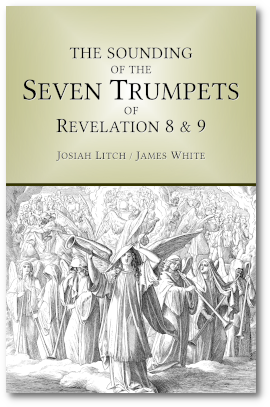 The main body of this shorter work on the Seven Trumpets of Revelation chapter 8 and 9 was taken from a work by Josiah Litch, written in 1842. James White republished it in 1859, and added a section at the end on the Seventh Trumpet.
The main body of this shorter work on the Seven Trumpets of Revelation chapter 8 and 9 was taken from a work by Josiah Litch, written in 1842. James White republished it in 1859, and added a section at the end on the Seventh Trumpet.
In 1866, the pamphlet was reprinted, with some revisions. Uriah Smith included it also in his first book, Thoughts, Critical and Practical on the Book of Revelation (1865), so it is possible that he was responsible for the revisions.
The prophetic exposition of the Seven Trumpets was an important part of the evidence given for the nearness of Christ’s second advent. Two time prophecies are located in the fifth and sixth Trumpets which help to establish the year-day principle of prophetic interpretation.
I have included a Foreword which explains the spiritual lesson in the prophecies of the Seven Trumpets. 64p
The Life and Labors of Joseph Bates
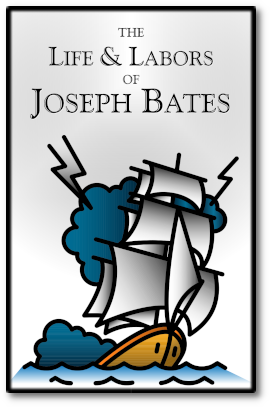 Very few pioneers carried on from the American Advent revival into the Seventh-day Adventist church. Joseph Bates was one of those few. This is his autobiography.
Very few pioneers carried on from the American Advent revival into the Seventh-day Adventist church. Joseph Bates was one of those few. This is his autobiography.
About 3/4 of the book deals with his life as a sailor, and later a captain. Even in this phase of his life, he was being led and prepared for his role in the Advent movement. He came under conviction: both regarding his moral condition, and his physical habits. Of his own accord he gave up first hard alcohol, then all alcohol, and then coffee and tea.
Later, swearing was also given up: not such an easy task for a sailor, for whom swearing was considered the common language of the profession! Eventually, he attained full conversion, and the knowledge that his sins were washed away in the blood of Christ.
As a captain, he implemented these reforms on his ship: forbidding the use of alcohol, discouraging swearing, and encouraging the sailors to spend Sunday in religious exercises (he did not know about the Sabbath at that time).
When he retired from seafaring life, he was involved in numerous reform societies, but soon his attention was turned to the Advent revival, and the love of this truth swallowed up all other interests. His recounting of this history gives us a front-row seat in the exciting years that preceded the closing of the Biblical prophetic periods. 289p
Discussion on the Sabbath Question
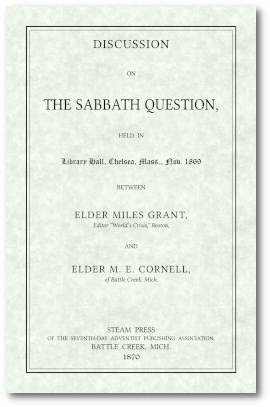 Here is an interesting piece of history. During the time of the pioneers, Adventists were sometimes involved in public debates, usually regarding the Sabbath doctrine. This is, to my knowledge, the only printed record of one of those debates. Merritt Cornell is defending the Sabbath against Miles Grant, who is an Advent Christian, but doesn’t believe in the seventh-day Sabbath.
Here is an interesting piece of history. During the time of the pioneers, Adventists were sometimes involved in public debates, usually regarding the Sabbath doctrine. This is, to my knowledge, the only printed record of one of those debates. Merritt Cornell is defending the Sabbath against Miles Grant, who is an Advent Christian, but doesn’t believe in the seventh-day Sabbath.
Although parts of the discussion were made up of notes, and therefore are not exact, and there are sometimes arguments missing that are referred to by the other side, it gives us some insight into the reasoning used by the early Adventists when they defended the Sabbath.
It is especially interesting to see how they handled anti-Sabbath arguments drawn from the book of Galatians, since that is the book which got E. J. Waggoner into trouble, many years later, when he showed clearly that the moral law, as a “schoolmaster,” was especially pointed out as having “passed away” after it led the repentant believer to Christ to receive righteousness. On this issue, Cornell falls short, as his fellow pioneers often did, of seeing the full extent of the law indicated in Galatians, and the danger of legalism.
I’ve also included a foreword which contains statements from Ellen White regarding the danger of a spirit of pugilism that could arise in debating, and some discussion of the law as related to the Sabbath, and the book of Galatians. 137p
Facts for the Times
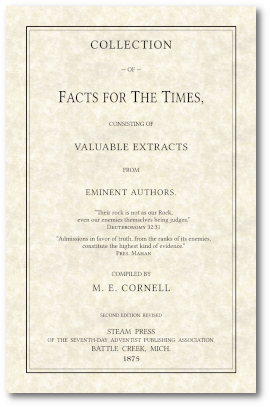 In this particular work Merritt Cornell has gathered together many historical quotations and statements that support various points of Adventist truth, thus showing that they are not entirely unique or odd ideas, but that these special truths have been entertained by others, at other times, although they did not see the entire framework of truth, but only a small piece.
In this particular work Merritt Cornell has gathered together many historical quotations and statements that support various points of Adventist truth, thus showing that they are not entirely unique or odd ideas, but that these special truths have been entertained by others, at other times, although they did not see the entire framework of truth, but only a small piece.
For His last work in the world, God has gathered together all these gems of truth, and placed them in their order, each part
connected to the other, so that the faith and obedience of His people can be perfected in these last days, as they study the glorious picture of Christ therein revealed.
I have prefaced this work with some Biographical Details, some Testimonies from Merritt and his wife Angeline, and some Poems from Angeline Cornell. 220p
Contents
- Use of the Scriptures
- Tradition Against Reform
- Likeness of Catholicism to Paganism
- Increase of Knowledge
- The Prophecies
- The Prophetic Periods
- Fall of Babylon
- The United States in Prophecy
- Blasphemous Character of the Papal Power
- The Temporal Millennium or The World’s Conversion a Fable
- Signs of the Times
- The World Waxed Old
- The Second Advent
- Perpetuity of the Moral Law
- The True Bible Sabbath
- Baptism by Immersion
- Is the Soul Immortal?
- Death of Christ
- Ordinance of Humility
- Miscellaneous
Christ in the Old Testament
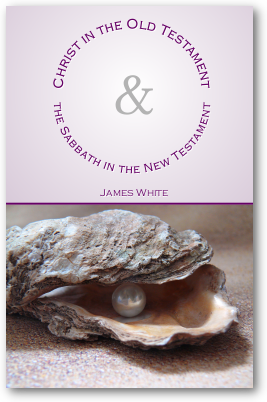 The full title of this work is “Christ in the Old Testament and the Sabbath in the New Testament.”
The full title of this work is “Christ in the Old Testament and the Sabbath in the New Testament.”
It is divided into three sections:
- Christ in the Old Testament
- The Sabbath in the New Testament
- The Old Moral Code Not Revised
The Bible proofs are clearly given that show that the seventh-day Sabbath has never changed, and is still the day of rest for believers in New Testament times, as it was for believers in Old Testament times. And the oft-repeated theory that nine of the ten commandments were re-affirmed in the New Testament is also analyzed.
As well, this booklet contains some of the basic groundwork of the Everlasting Gospel message. It shows that Christ was active throughout the Bible, in the Old and the New Testament periods, as the connector and communicator between man and God. It shows that the plan of salvation has been the same in all ages, and that the New Testament is built on the foundation of the Old. 52p
Note: The Audio (MP3) download is a reading of the first part only (Christ in the Old Testament); it does not contain a reading of the second part (The Sabbath in the New Testament).
Bible Adventism
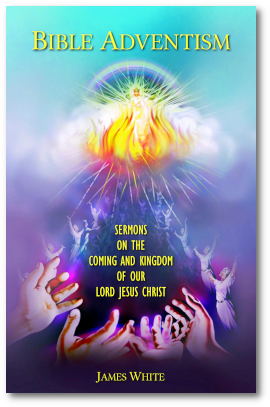 Here is a classic work from the pen of James White, the “pioneer of pioneers.”
Here is a classic work from the pen of James White, the “pioneer of pioneers.”
It is a series of 10 Sermons covering the prophecies that mark out our days as “the time of the end.” It goes through the prophecies of Daniel, down through the prophetic chain of kingdoms, showing that we are on the doorstep of Christ’s eternal kingdom.
There are about 50 pages devoted to the prophecy of the 2300 days of Daniel 8:14, which unfold the Sanctuary truth.
This is foundational Advent material, from a man who had a deep experience in this message. 201p
Contents
- Introduction
- The Millennium
- The Second Advent
- Noah’s Time, and Ours
- The Church Not in Darkness
- The Time of the End
- The Kingdom
- The Judgment
- The Time
- The Sanctuary
- Saving Faith
Sabbath Collection
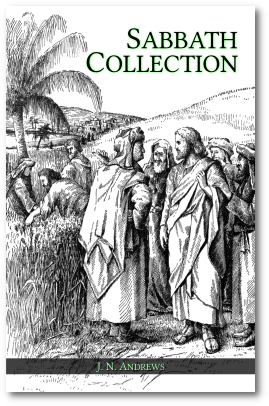 In this collection are gathered the writings by J. N. Andrews on the topic of the Sabbath, from one of the earliest pamphlets on the Sabbath truth, into more elaborate sermons and writings establishing the historical and Biblical foundation of the Sabbath within the framework of the Law and the Gospel.
In this collection are gathered the writings by J. N. Andrews on the topic of the Sabbath, from one of the earliest pamphlets on the Sabbath truth, into more elaborate sermons and writings establishing the historical and Biblical foundation of the Sabbath within the framework of the Law and the Gospel.
Andrews’ larger book, History of the Sabbath, is not included in this collection, but will be released as a separate book when ready.
Andrews had a fairly good grasp of the two covenants also, shown in one of the sermons by that name. This preceded E. J. Waggoner’s discussions about that topic, and was inline with what Waggoner later taught. Andrews understood and taught that the Gospel did not supersede the Law, but provided a way whereby its righteousness could be fulfilled in the believer.
While these writings do not go into depth on the spiritual meaning of the Sabbath, they do establish the foundation for its veracity and morality. 409p
Contents
- Thoughts on the Sabbath (1851)
- The Perpetuity of the Law of God (1851)
- The Perpetuity of the Royal Law (c1854)
- Review of Objections to the Seventh-day Sabbath (c1854)
- The First Day of the Week not the Sabbath of the Lord (1855)
- A Refutation of the Claims of Sunday-keeping to Divine Authority (c1858)
- The Sabbatic Institution (1860)
- The Two Laws (1860)
- The Definite Seventh Day (nd)
- Sermons on the Sabbath and the Law (1870)
Conditional Immortality Collection
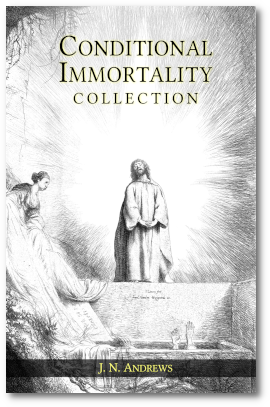 In this collection are gathered four writings by J. N. Andrews, on the topic of “Conditional Immortality.” This topic includes discussions on the nature of the soul, death, hell, and communications with supposed “departed souls.”
In this collection are gathered four writings by J. N. Andrews, on the topic of “Conditional Immortality.” This topic includes discussions on the nature of the soul, death, hell, and communications with supposed “departed souls.”
There are many reasons why the truth about man’s natural mortality is an important pillar in the Advent faith:
- It shows that eternal life is only in Christ, thus exalting Him, through the gospel, as the only life-giver (second
Adam) to the human race. - It reiterates the truth that sin leads to death. Satan had deceived Eve by saying, “You shall not surely die.” The doctrine of the “immortality of the soul” carries on this lie. But the truth on man’s mortality shows that God was not lying, and that sin is only a curse, and the source of all other curses. Thus, it proves that God is the life-giver, and sin is the life-taker.
- It exposes the fallacy of spiritualism, which is communication with dead people who are supposedly in heaven. Thus it shuts the door to one of Satan’s most devious deceptions.
- It highlights the importance of the Judgment, which must take place before the resurrection, and the giving of rewards. No one passes directly to heaven at death, for all must go through the Judgment first.
- It re-establishes the apostolic hope in the resurrection as the time when the saints will be reunited with Christ and their fellow believers.
- It exposes the error of an “eternally burning hell” which had darkened the character of God for centuries.
For all these reasons, this truth takes its place as part of the “everlasting gospel” message, which is to fill the Earth with glory, before the second advent of our Lord Jesus Christ. 97p
Contents
- Departing and Being with Christ
- The Rich Man and Lazarus
- Samuel and the Witch of Endor
- Thoughts for the Candid
The Complete Testimony of the Fathers
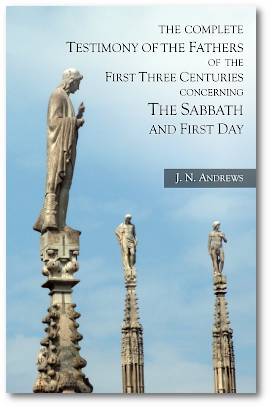 Advocates for Sunday allowed their zeal for their tradition to get the better of their scholarship, and misused the writings of the early church Fathers (100AD-300AD) in order to gather support for the idea that Sunday was an apostolical institution, observed immediately as a replacement for the Sabbath in the early church.
Advocates for Sunday allowed their zeal for their tradition to get the better of their scholarship, and misused the writings of the early church Fathers (100AD-300AD) in order to gather support for the idea that Sunday was an apostolical institution, observed immediately as a replacement for the Sabbath in the early church.
Because of this, defenders of the seventh-day Sabbath truth found it necessary to investigate these writings, to see if it were indeed as these advocates claimed. This book is the result of the researches of J. N. Andrews, into the writings of the early church Fathers. It gathers together all the statements of these so-called “fathers” regarding the Sabbath, the Lord’s Day, and their views on the Law of God (whether it is applicable to Christians or not).
What appears, from all the evidence, is that there was a gradual falling away from the truth. Initially, many Christians observed the Sabbath. They also began to observe Sunday as a festival, but not as a replacement for the fourth commandment. As time passed, the Sabbath was oppressed, and Sunday was exalted. These movements were gradual, and there was not an immediate change originating from the Apostles’ days, nor was there a unity of views among the so-called early church Fathers.
This book is a handy resource for students interested in the history of the Sabbath controversy. 107p
Contents
- Introductory Statement
- Testimony of the Apostolical Constitutions
- Testimonies, 100-125 AD
- Testimony of Justin Martyr, 140 AD
- Testimonies, 150-180 AD
- Testimonies, 180-195 AD
- Testimony of Tertullian, 200 AD
- Testimonies, 200-250 AD
- Testimonies, 250-300 AD
- Testimonies, 300 AD
The Atonement
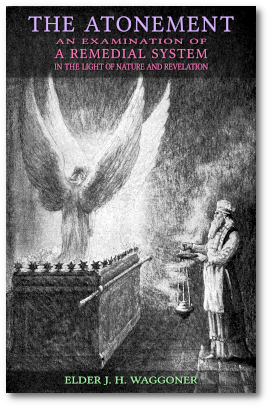 This is an extensive, theological work by the father of E. J. Waggoner: advent pioneer J. H. Waggoner.
This is an extensive, theological work by the father of E. J. Waggoner: advent pioneer J. H. Waggoner.
One of the main thoughts of this work is to show the centrality of the Law in God’s system of moral justice, and in the work of atonement for sin. The author shows the numerous errors that develop when the Law of God is excluded from the work of the Gospel. The author states:
There are no isolated, independent truths in the great plan of salvation. It takes all the truths and doctrines of the Bible to make one complete system; and the Atonement is the great central work, by virtue of which all other parts of the work of salvation and redemption are carried out.
There are chapters at the end covering “the Judgment,” “The Scape-Goat,” “The Kingdom of Christ,” and the final redemption of the Earth, thus showing that the Atonement involves much more than just the individual salvation of sinners. 323p
Contents
- Comparison of Nature and Morality
- The Moral System
- Requirements of the Moral System
- Principles of the Divine Government
- Sin and Its Penalty
- Justification and Obedience
- Death of Christ Vicarious
- The Son of God Died
- Doctrine of the Trinity Subversive of the Atonement
- What the Atonement Is
- The Judgment
- The Scape-Goat
- The Kingdom of Christ
- Redemption
- Conclusion
Part 1: The Atonement Consistent With Reason
Part 2: The Atonement as Revealed in the Bible
Bible-Hygiene
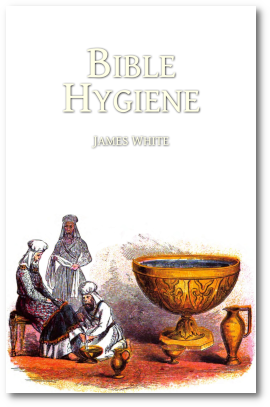 Early on in the growth of the Seventh-day Adventist church, God directed the believers to the importance of health and health principles in their cooperation with Christ in the perfecting of holiness.
Early on in the growth of the Seventh-day Adventist church, God directed the believers to the importance of health and health principles in their cooperation with Christ in the perfecting of holiness.
At that time (mid-1800’s) there were many unhealthy practices which were not recognized as such by society, and many of the believers were suffering from diseases which proper diet and hygiene would have alleviated. They were zealous about the law of God, and obedience to it in the spiritual realm; but they needed to see that obedience to the laws of nature was just as much obedience to God as in the spiritual realm.
Many years later, in 1890, the writings of James and Ellen White on these topics were published in a volume titled, Christian Temperance and Bible Hygiene. The first part of the volume consisted of articles by Ellen White, and the second part contained articles by James White. As Ellen White’s works are widely available, I have only reproduced James White’s portion here.
It also contains some testimonies from the experiences of Joseph Bates and J. N. Andrews on the influence that health reform had on their lives.
I have also attached, in the Appendix, a small practical work that James White released in 1870, titled Small Fruits. It has farming information on the cultivation and preservation of small fruit crops. 137p
Contents
- The Love of God in Creation
- Food, Air, and Exercise
- Diet and Cleanliness of the Hebrews
- The Appetite in Human History
- The Power of Appetite
- Appetite Controllable
- The Gospel of Health
- Redemption
- Hygienic Reform: It’s Rise and Progress Among Seventh-Day Adventists
- Appendix: Small Fruits
Wine and the Bible
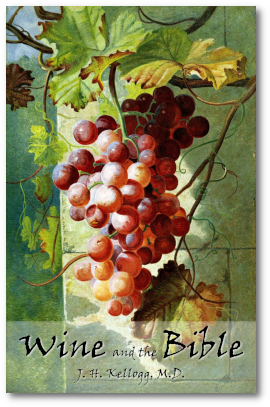 Here is a classic work by J. H. Kellogg on Temperance, covering the topic of “wine” in the Bible. It is subtitled, “A Consideration of the Use of Alcoholic Beverages from a Bible Standpoint.”
Here is a classic work by J. H. Kellogg on Temperance, covering the topic of “wine” in the Bible. It is subtitled, “A Consideration of the Use of Alcoholic Beverages from a Bible Standpoint.”
This booklet shows how the Bible is in harmony with science; how there are two kinds of “wine” recognized in the Bible; and then compares some Scripture examples of those who indulged in wine, and those who abstained. 29p
Contents
- Perversion of Scripture
- The Bible in Harmony with Science
- Two Kinds of Wine Recognized in the Bible
- Scriptural Distinctions of Wines
- Examination of Texts
- Use of Wine by Bible Characters
- Bible Teetotalers
- The Rum Family
God is Love
 George Fifield was an ordained minister and contemporary of E. J. Waggoner and A. T. Jones. He was associated with A. T. Jones in religious liberty work during the 1890’s.
George Fifield was an ordained minister and contemporary of E. J. Waggoner and A. T. Jones. He was associated with A. T. Jones in religious liberty work during the 1890’s.
This book was published in 1897. Other than the writings of Ellen White, it is the first book specifically devoted to the topic of God’s character. It is significant that this book appeared around the time of the beginning of the latter rain message in the 1890’s, as the theme of God’s character has reappeared in the return of the latter rain message in our time.
This book is not as comprehensive as the recent book, Behold Your God, and it also contains a few errors (for example, that the close of probation would not happen until the last of the seven plagues), but it is still a thought-provoking read. 222p
Contents
- Knowing God
- The Attributes of God
- Love the Source of Righteousness
- Satan’s Effort to Hide God’s Love
- The Fatherhood of God
- The Glory of God
- The Unity of the Law and the Gospel
- The Nature of the Divine Government
- The Law of Love
- The Two Ways
- The Design of the Law
- How Man Misunderstood His Maker
- The Atonement
- The Atonement Vicarious
- Miracles and their Meaning
- The Sacrifice of Christ Honors God’s Law
- God’s Dealing with the Wicked
- Why Has Sin Been Permitted so Long?
- Will there Be Gain?
- The Closing of Probation
- His Strange Act
- The Plagues of Egypt
- The Seven Last Plagues
- The Second Resurrection
To view the book in the archive.org online bookreader, click the following link:
God is Love. Or use the download link below to save the PDF locally.
May 2022 Update: The PDF is now bookmarked and the Table of Contents are hyperlinked, for easier browsing.
The Gospel of the Kingdom
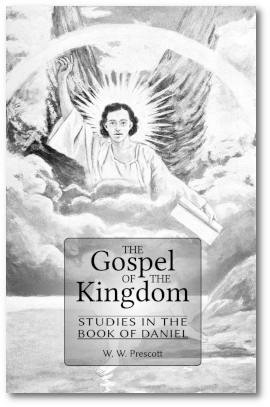 For a time, W. W. Prescott lent his abilities in the support of the 1888 message. The articles that comprise this book, which covers the first seven chapters of Daniel, are possibly the finest result, and they are indeed excellent.
For a time, W. W. Prescott lent his abilities in the support of the 1888 message. The articles that comprise this book, which covers the first seven chapters of Daniel, are possibly the finest result, and they are indeed excellent.
They were printed in the Present Truth magazine in 1900, while Waggoner was still the Editor, and he wrote the following glowing recommendation:
We know of nothing else published, which touches and makes clear the keynote of [the book of Daniel] as these articles do.
It’s a shame that Uriah Smith never caught the “1888 Message” flame, as his book on Daniel and the Revelation, while containing much historical information, is almost destitute of gospel teaching. By way of contrast, this book demonstrates how the gospel should be at the heart of all prophetic exposition. 223p
Contents
- Planting the Royal Seed
- Strengthened by Temperate Living
- The Divine Education
- God Arranges a Test
- The Philosophy of Human History
- An Everlasting Kingdom
- Self-Exaltation
- Gospel Liberty
- Righteousness by Faith is Presented
- Conversion of the King of Babylon
- Modern Babylon
- The Wine of Babylon
- The Time of Judgment Arrives
- The Cause of Babylon’s Fall
- Babylon is Fallen, is Fallen
- Men Ought Always to Pray
- Deliverance from Death
- Modern Babylon in Prophecy
- The King of Modern Babylon Exalts Himself
- Works Substituted for Faith
- Paganism Substituted for Christianity
- The Gospel is the Answer
- Afterword
Wrested Scriptures Made Plain
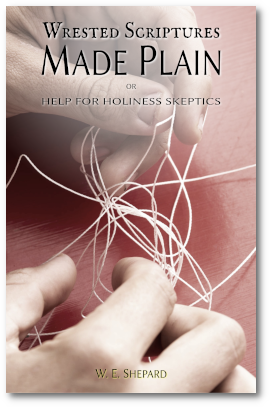 Here is a book from a Wesleyan Methodist Pentecostal minister, published in 1900. I’m including it among our “Pioneer” collection, because the Methodist Pentecostals, unlike the more modern Pentecostals we are familiar with, emphasized Holiness, or Sanctification. They taught the cleansing away of the carnal mind, which is very similar to the gospel we believe in today.
Here is a book from a Wesleyan Methodist Pentecostal minister, published in 1900. I’m including it among our “Pioneer” collection, because the Methodist Pentecostals, unlike the more modern Pentecostals we are familiar with, emphasized Holiness, or Sanctification. They taught the cleansing away of the carnal mind, which is very similar to the gospel we believe in today.
The plan of the book was to take each of the main scriptures which were commonly used to deny the possibility of holy living, and then expound their true meaning, so that the harmony with the rest of the testimony of the Bible could be seen.
This topic is particularly useful today, when there seem to be almost endless excuses being taught in the modern churches,
against holy living, and against the possibility of living a life of victory over sin. The same arguments, based on the same misinterpretation of the same Bible texts, are still being promulgated today.
Therefore, I release this book again, as an arrow from the Lord’s quiver, to shoot into the heart of the lies and unbelief that stalk the land like Giant Despair, robbing the children of God of their rightful heritage as sons and daughters of the King of righteousness. 145p
Contents
- If We Say We Have No Sin
- There Is None Righteous
- For There Is No Man That Sins Not
- Paul Not Perfect
- Job Disclaiming Perfection
- Paul, the Chief of Sinners
- I Am Pure from My Sin
- The Seventh Chapter of Romans
- Paul’s Thorn in the Flesh
- The Statements of Job’s Comforters
- There Is None Good but One
- Our Vile Body
- I Die Daily
- Be Angry and Sin Not
- Forgive Us Our Sins
- I Keep Under My Body
- Be Not Righteous Overmuch
- A Just Man Falls Seven Times
- I Have Seen an End of All Perfection
- Summary
- Conclusion
Letters to the Churches
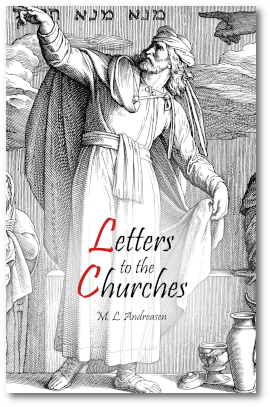 When the “omega” of apostasy entered the Seventh-day Adventist church in the 1950’s, one man had the courage to give the trumpet a clear warning sound. That man was M.L. Andreasen (1876-1962), who served the church his whole lifetime as pastor, evangelist, teacher, theologian, and author.
When the “omega” of apostasy entered the Seventh-day Adventist church in the 1950’s, one man had the courage to give the trumpet a clear warning sound. That man was M.L. Andreasen (1876-1962), who served the church his whole lifetime as pastor, evangelist, teacher, theologian, and author.
The apostasy was crowned with a meeting of Adventist and Evangelical Protestant leaders, whereby the Adventists made changes to some of their core doctrines, in order to be seen as “brothers in Christ” with the Protestant evangelicals. These changes were publicized in a book called “Questions on Doctrine.”
Andreasen was alarmed, and after a futile attempt to protest to the leadership, he wrote a series of six studies in protest, which were eventually gathered and published by others as a single booklet. He correctly saw that the “foundation pillars” of Adventism were being destroyed, the church was being “sold down the river,” and the doctrine of Antichrist was being embraced. In his own words:
“This is more than apostasy. This is giving up Adventism. It is the rape of a whole people. It is denying God’s leading in the past.”
Because his protest was considered too damaging and critical to the church, his ministerial credentials were removed, which was heart-breaking to him. Shortly after he contracted an ulcer in his duodenum and was not strong enough to undergo surgery, and died less than a year after his credentials were revoked.
Although a biography of his life was written that downplayed his protest as unwarranted criticism, and tried to gloss over all the doctrinal changes, other Adventists saw the problems as well, and also raised a protest.
Another factor, which Andreasen did not deal with, was the agitation over the writings of Waggoner and Jones, also called the “1888 Message”. Because the changes of doctrine by the Adventist leaders involved a neglect and even rejection of that gospel message, it was more serious than many suppose. A more full treatment of the issues involved can be found in the book “The Destiny of a Movement”.
Although there was more to the issue than just change of doctrine, Andreasen’s parting work still speaks today. I have reformatted it for ease of reading. 117p
Updated Jan 2023: New ePDF formatting rules applied, new cover, some corrections, addition of “I have not recanted” letter.
Contents
- Letter 1: The Incarnation: Was Christ Exempt?
- Letter 2: Attempted Tampering
- Letter 3: Down-Grading Mrs White
- Letter 4: A Resume
- Letter 5: Why Not a Hearing?
- Letter 6: The Atonement
- Letter: I Have Not Recanted
- Brief Biography of Milian Lauritz Andreasen
The Vision by the Hiddekel
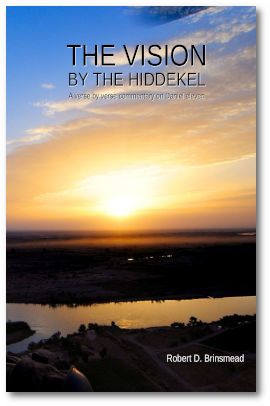 Robert Brinsmead, an Australian Seventh-day Adventist, spearheaded the “Awakening” message during the 1960’s. This was a “wake-up” call to the church, and a revival of the uniquely Adventist gospel message given to the church in 1888 by two young ministers, A. T. Jones, and E. J. Waggoner.
Robert Brinsmead, an Australian Seventh-day Adventist, spearheaded the “Awakening” message during the 1960’s. This was a “wake-up” call to the church, and a revival of the uniquely Adventist gospel message given to the church in 1888 by two young ministers, A. T. Jones, and E. J. Waggoner.
This “1888 message” had been almost forgotten many years after it was first presented, but in the mid 1900’s it was re-discovered, and caused agitation within the church, but rejoicing among those who were blessed by its light.
Robert, along with his brother John, were pre-eminent among those who reintroduced that lost message.
This book on the prophecies of Daniel, especially those of chapter eleven, is by far the best and clearest Adventist exposition of that important chapter, ever published. Therefore a recirculation is fully justified.
Within its pages the light of the everlasting gospel message of Revelation 14 is turned upon the prophetic utterances. Even the most obscure passages sparkle with new light and truth. They shine out in a beauty and simplicity not seen before. The prophecies are transformed into the faith-building bread of life in those believers who make up Christ’s spiritual temple: the church of the living God.
Robert Brinsmead eventually left the truths he once proclaimed, but the truth has not changed because of that. Truth is eternal. It does not pass away. 150p
For all flesh is as grass, and all the glory of man as the flower of grass. The grass withers, and the flower thereof falls away: but the word of the Lord endures for ever. And this is the word which by the gospel is preached unto you. 1 Peter 1:24-25
God’s Eternal Purpose
 Here is a classic from the beginning of the revival of the 1888 message. Robert Brinsmead was the leading voice in the “Awakening” movement of the late 1950’s and early 1960’s. This was the defining work of that movement.
Here is a classic from the beginning of the revival of the 1888 message. Robert Brinsmead was the leading voice in the “Awakening” movement of the late 1950’s and early 1960’s. This was the defining work of that movement.
Subtitled as “The Gospel of Jesus Christ in the Light of the Sanctuary Service,” it shows some of the beautiful gospel truths that have come to light through the revelation of the Heavenly Sanctuary Service, where Christ ministers as High Priest.
Fred Wright was a member of the Awakening in those early days, and many of the phrases, statements, proofs, and truths that he later taught owe something to the light revealed in those earlier days.
This is a faithful reproduction of the original, although it has been reformatted, and I have added 50+ historic Bible pictures, and a transcribed Autobiography of Robert Brinsmead in the Appendix.
I have also included a Foreword explaining the background of the work, and outlining which interpretations were not quite correct, and were later corrected in the ministry of F. T. Wright. I’ve also added a few footnotes on those disputed points, as they appear in the book.
In spite of these few differences, the work can be read with great profit by all, and will broaden the understanding of the history of how God led. 416p
The Image of a Man
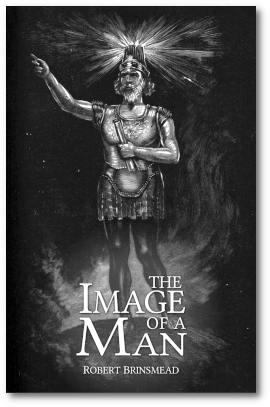 A lot of human speculation has gone into trying to understand the image, mark, number, and name of the beast of Revelation 13. This booklet is not like that. It is a penetrating look into this mystery with the magnifying glass of the gospel.
A lot of human speculation has gone into trying to understand the image, mark, number, and name of the beast of Revelation 13. This booklet is not like that. It is a penetrating look into this mystery with the magnifying glass of the gospel.
The image, mark, number, and name of the last apostate union of man will be but the repetition on a larger scale, of the apostasies that have gone on through all time, starting with the offering of Cain, the Image of Nebuchadnezzar, the Pharisees in Jesus’ time, the Papacy, and on down to the time of the end. 15p
Ecclesiastes 1
9 The thing that has been, it is that which shall be; and that which is done is that which shall be done: and there is no new thing under the sun.
10 Is there any thing whereof it may be said, See, this is new? it has been already of old time, which was before us.
What Was the 1888 Message?
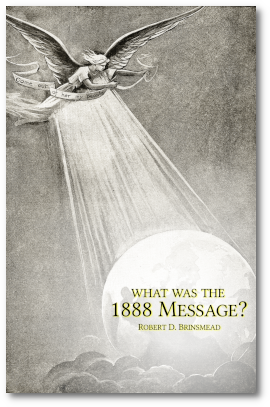 The Brinsmead “Awakening” movement of the late 1950’s and early 1960’s was a true revival of the 1888 Adventist gospel message.
The Brinsmead “Awakening” movement of the late 1950’s and early 1960’s was a true revival of the 1888 Adventist gospel message.
This pamphlet, published during that revival, explains the 1888 gospel, and in what ways it is the same as that taught by the Protestant Reformers, and in what ways it goes further.
It also contains the earliest application (that I can find) of the two calls to the wedding feast in the parable of Matthew 22, to the 1888 message (the first call), and the revival of that message in the 1950’s and 60’s (the second call). 35p
Contents
- What Was the 1888 Message?
- Brief Review of the Sanctuary Service
- 1888: The Uplifted Cross
- Justification
- Cleansing
- Obedience
- 1888 Message: Centered in the Most Holy Place
- Judgment: Justification Full and Complete
- Babylon Fallen: Deliverance Full and Complete
- The Third Angel: Obedience Full and Complete
- Our Call to the Marriage
The Three Angels’ Messages in the Book of Daniel
 Here is a booklet from Robert Brinsmead (see the info about him in the previous book description), from the “Awakening” time period (late 1950’s to early 1960’s).
Here is a booklet from Robert Brinsmead (see the info about him in the previous book description), from the “Awakening” time period (late 1950’s to early 1960’s).
It reveals the clear link between the book of Daniel, especially the message on the Sanctuary and its cleansing, and the final work accomplished for God’s people on earth, and in the temple in heaven, during the time covered by the first three angels of Revelation 14.
It forges a gospel link between the prophecies of Daniel and those of Revelation, showing that they are all part of one connected everlasting Gospel plan. 36p
Contents
- The Three Angels’ Messages in the Book of Daniel
- Spiritual and Physical Desolation
- Daniel Understands 70 Years
- Daniel Faints
- Daniel’s Problem Answered
- History is Repeated
- Final Conflict of the Church
- The Time Draws Nigh
- God’s Strategy of Final Deliverance
- The Judgment
- Victory Through the Final Atonement
- The Loud Cry
- Armageddon
How is Perfection Possible?
 This small booklet comes from the early days of the Brinsmead Awakening message. It is a very brief presentation of the steps by which Christ brings His people to perfection in preparation for His second advent: Justification, Sanctification, and Final Atonement.
This small booklet comes from the early days of the Brinsmead Awakening message. It is a very brief presentation of the steps by which Christ brings His people to perfection in preparation for His second advent: Justification, Sanctification, and Final Atonement.
Of particular interest is the use of the word “eradication” when referring to the cleansing of sin from the heart, just prior to the new birth. This is a word that was to be used by F. T. Wright quite a bit, in his presentation of the gospel, which carried on the work that was begun by the Awakening message. 14p
Contents
- How is Perfection Possible?
- The Condition of the Natural Man
- A Change of Nature Required
- First Step: Justification
- Second Step: Sanctification
- Third Step: Final Atonement
How to Keep the Doctor Away
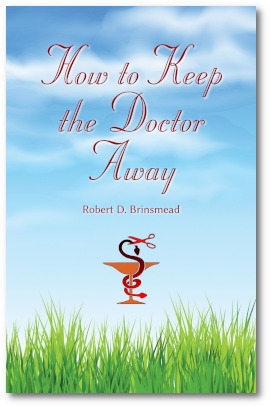 For a nice change from our usual theological material, I’m happy to present this booklet on health principles from the Brinsmead Awakening message era.
For a nice change from our usual theological material, I’m happy to present this booklet on health principles from the Brinsmead Awakening message era.
It covers the basic health laws, in a nicely illustrated presentation, and includes some articles on the power of the Gospel as an important agent of health. 69p
Contents
- Health and the Physical Laws of Life
- The Relation Between the Mind and Good Health
- The Moral Laws of Life
Man Born To Be King
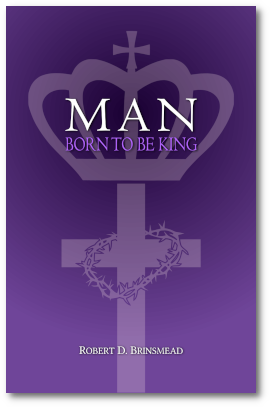 This book is devoted to a discussion of man—his purpose, potential, and ultimate destiny as revealed in the gospel, in prophecy, and shadowed forth in the sanctuary service.
This book is devoted to a discussion of man—his purpose, potential, and ultimate destiny as revealed in the gospel, in prophecy, and shadowed forth in the sanctuary service.
The unfolding of the gospel plan as revealed in the sanctuary service brings into view the finishing of God’s work for man, as prefigured in the Day of Atonement, the second last of a series of seven feasts, that marked out the religious year in the Old Testament.
Many prophecies also point to this aim. Here are a few of them:
- Daniel 8:14 – The Cleansing of the Sanctuary
- Daniel 7 – The Judgment Scene that Justifies the Saints
- Mark 4:26-29/ Revelation 14:14-16 – The Harvest of Ripened Characters
- Revelation 3:8 / Revelation 11:19 – The Open Door into the Most Holy Place
- Revelation 7 – The Sealing of the 144,000 Living Saints
- Revelation 10:7 – The Finishing of the Mystery of God (Christ in Us)
Man’s redemption back to kingship is accomplished through the work of salvation from sin. But God’s plan encompasses more than just individual salvation. God’s name is to be revealed through His people, just as it was revealed through Christ, when He came as a man. It is this revelation which will close the battle between Christ and Satan. 180p
“God’s honor is at stake in the perfection of the saints. From the beginning of the great controversy, Satan has claimed that it is impossible to keep the law of God. God’s final answer is to perfect a people through the work of cleansing the sanctuary, and answer the challenge of Satan.” (p. 166)
Contents
- For Thrones and Dominions
- Original Sin
- The Seed of the Woman
- It Is Finished
- The Stream from the Heavenly Sanctuary
- The Door of Faith
- The Imputed Gift
- Dead, Buried, Risen
- Bible Sanctification
- The Hour of His Judgment Is Come
- Three Angel Messages
- Perfecting the Saints
- The Final Generation
Gems of Truth, Book 1
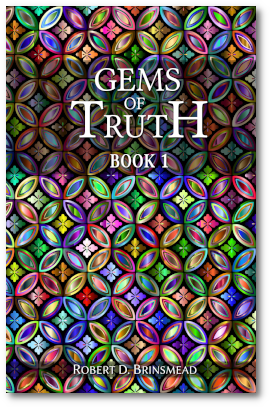 Here is the first volume of a two-volume set of collected Articles and transcribed Sermons by Robert Brinsmead, a man whom God used to spearhead the revival of the 1888 message in the late 1950’s and into the 1960’s.
Here is the first volume of a two-volume set of collected Articles and transcribed Sermons by Robert Brinsmead, a man whom God used to spearhead the revival of the 1888 message in the late 1950’s and into the 1960’s.
This volume is full of the treasures of truth that the Advent message has brought to the understanding of the Gospel, and to the prophetic understanding of the finishing of God’s work on Earth, and the role of the Church in those closing scenes.
If you are familiar with the writings of E. J. Waggoner and A. T. Jones, you will find these articles to be much the same: full of clear teaching about righteousness by faith, and how that practically works out into perfect obedience to all the commandments of God.
There are articles on Christ’s union with our human nature, on the Love of God as expressed in the gift of Christ, on the nature of saving faith, on the spiritual meaning of the Sanctuary service, on the soon-coming spiritual battle, and what it means to “follow the Lamb withersoever He goes.”
Much of the important teaching of the Brinsmead “Awakening” message (as it was called), was carried over into the ministry of Fred Wright, who fellowshiped with the Awakening believers in the early years. Yet there are still rays of light and insights that I had not read or heard before.
I believe there is a blessing in going back to the foundation and studying it more closely to see how God has worked, and therefore, I release these articles for the benefit of others. There are 56 articles in total, so I have not listed the Contents, as it would be too long. 732p
Gems of Truth, Book 2
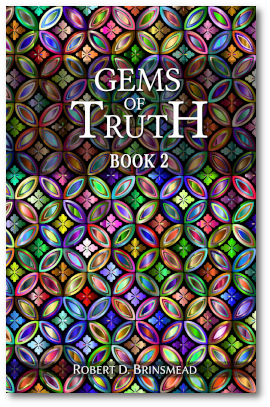 Here is the second volume of a two-volume set of the early writings of Robert Brinsmead, a man whom God used to spearhead the revival of the 1888 message in the late 1950’s and into the 1960’s.
Here is the second volume of a two-volume set of the early writings of Robert Brinsmead, a man whom God used to spearhead the revival of the 1888 message in the late 1950’s and into the 1960’s.
This volume is full of the treasures of truth that the Advent message has brought to the understanding of the Gospel, and to the prophetic understanding of the finishing of God’s work on Earth, and the role of the Church in those closing scenes.
If you are familiar with the writings of E. J. Waggoner and A. T. Jones, you will find these articles to be much the same: full of clear teaching about righteousness by faith, and how that practically works out into perfect obedience to all the commandments of God.
There are articles on the Gospel, the Incarnation, Prophecy, the Sanctuary, Health, and the Awakening Movement. Much of the important teaching of the Brinsmead “Awakening” message (as it was called), was carried over into the ministry of Fred Wright, who fellowshiped with the Awakening believers in the early years. Yet there are still rays of light and insights contained in these early articles, that I had not read or heard before.
I believe there is a blessing in going back to the foundation and studying it more closely to see how God has worked, and therefore, I release these articles for the benefit of others. There are 26 separate writings in total, mostly drawn from published pamphlets. I have reproduced the images and diagrams from the original pamphlets, or in some cases I have replaced them with better ones. 844p
Contents
- Preparing for Translation
- The Men of Romans 7 and 8
- Trying the Spirits
- The Way to Perfection
- Zechariah: Prophet of Encouragement
ARTICLES ON THE GOSPEL
- Like Unto His Brethren
- The Incarnation
- Historical Survey of the Incarnation
ARTICLES ON THE INCARNATION
- The King of the North and The King of the South
- Kings of the East
- The Mystery Finished
- The Times of the Gentiles
- Crisis and Victory in Revelation 13 and 14
- Revelation 17
- Tidings of Great Joy
ARTICLES ON PROPHECY
- Importance of the Sanctuary Truth
- The Open Door
- The Third Angel’s Message
- Prepare the Way of the Lord
- Atonement with the Scapegoat
- Individuality and the New Covenant
- Hebrews 10: Into the Holiest
ARTICLES ON THE SANCTUARY
- Healthful Living
- Harvest of Health
ARTICLES ON HEALTH
- Foundation and Progress
- Our Present Position
ARTICLES ON THE MOVEMENT
Restoration and Revelation
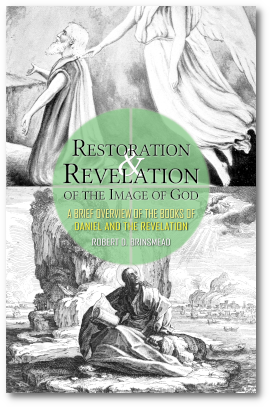 The light from the Bible is exhaustless, so there is always room for another exposition of the prophetic books of Daniel and the Revelation.
The light from the Bible is exhaustless, so there is always room for another exposition of the prophetic books of Daniel and the Revelation.
This is just a small booklet, but contains some real gems. It is a brief overview of these two prophetic books, emphasizing that their purpose is to form a people in whom the moral image of God is restored, and then revealed to all the world, in the closing gospel work, and further yet, in the battle of Armageddon. 20p
Contents
- The Message of Daniel
- The Interdependence of the Fourfold Restoration
- The Place of the Judgment
- The Message of Revelation
- The Outline of Revelation
- The Battle of Armageddon
The Battle for the Mind
 Here is another interesting gem from the Brinsmead Awakening. From the Preface:
Here is another interesting gem from the Brinsmead Awakening. From the Preface:
Man is born on a battlefield. The real battle of history is not for provinces, cities or wealth. It is a battle for the mind—for your mind and mine. Never have men lived in such an age as today. Intensity is taking possession of every earthly element as history rushes on to a great final battle which will end the war. There is no place to hide. You cannot be neutral.
This book is contains the Bible text entire, of Daniel chapters 2 through 12, and Revelation, chapters 10 through 22. There are marginal comments explaining some of the symbols, and some other small sections of comments in between the chapters. There are also quite a number of diagrams, and some pictures. 79p
But mainly, the reader is left to dwell upon the sacred text itself. The Preface closes:
The prophecies of Daniel and John challenge you, reader, to do something that the multitude does not want to do—think! Then you will be an intelligent participant in the greatest battle ever fought—the battle for the mind.
Contents
- First Prophecy: Restoration of the Kingdom
- Second Prophecy: Restoration of the King
- Third Prophecy: Restoration of the Sanctuary
- Fourth Prophecy: Restoration of God’s People
- War on the Bible: The Rise of Atheism
- War on the Law
- God’s Last Message — Christ Returns
- A New Heaven and a New Earth
The Prophecies of Daniel
The Prophecies of Revelation
